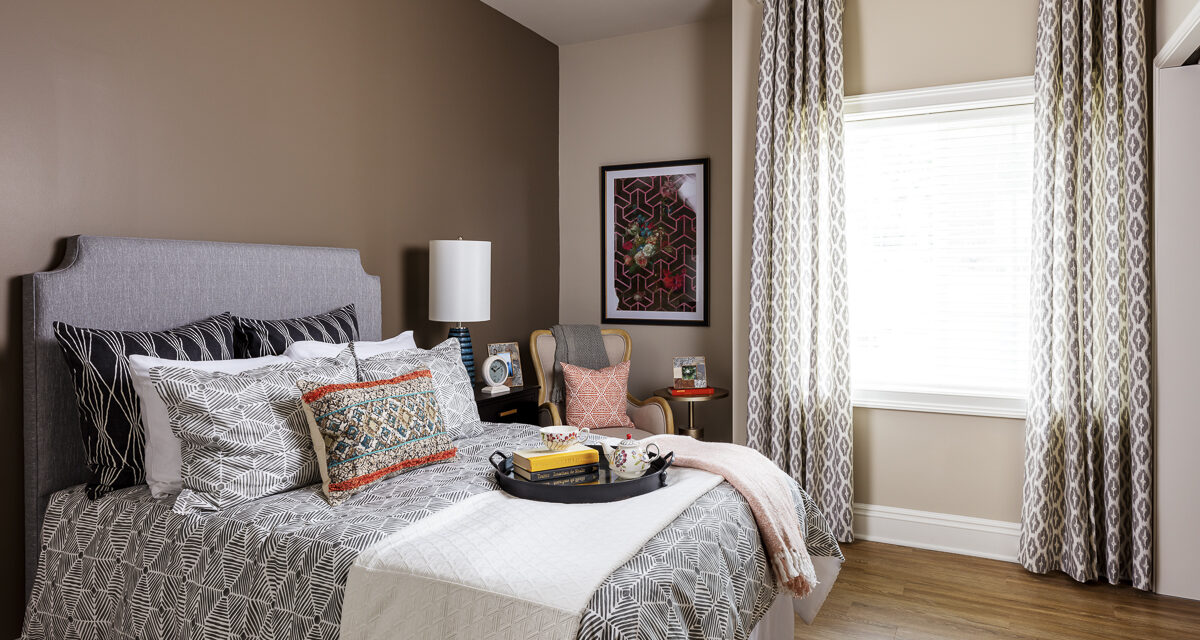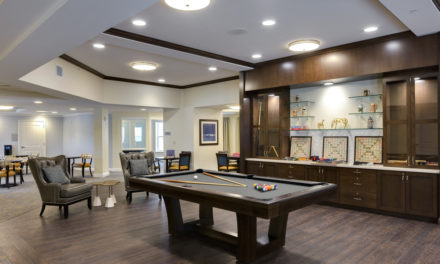In today’s most innovative care environments, the resident bedroom is more than a place to rest. It’s a reflection of identity, a tool for care, and a space that promotes dignity and well-being. As expectations evolve, design must meet the moment by blending performance, personalization, and peace of mind. Explore five resident-centered strategies that help transform bedrooms into supportive, engaging spaces where seniors can thrive.
1. Use calming color palettes and layered lighting
Color and lighting decisions impact not only how residents feel but also how safely they can move through a space. Choosing calming, biophilic tones like soft terracotta, sandy neutrals, coastal blues, and leafy greens helps create a restorative environment that reduces agitation while maintaining a professional, long-lasting finish that requires minimal upkeep.
In memory care, avoid very dark flooring, which may appear like holes or unsafe areas to residents with cognitive impairment and increase fall risk. Instead, use clear contrast between walls, floors, and furniture to define boundaries and support safe navigation. For example, pair neutral walls with slightly darker casegoods, or select light bedding against a darker bedframe to make furniture edges more visible.
Layering lighting— ambient, task, and night— offers flexibility while reducing unnecessary staff interventions. Well-placed fixtures and durable materials minimize maintenance while providing consistent performance. Circadian lighting systems that mimic natural daylight cycles not only enhance resident sleep but also extend fixture longevity by operating efficiently.
Tip: Add motion-activated nightlights near the bed or pathway to the bathroom. These simple upgrades support safety without disrupting rest and can reduce the number of nighttime staff interactions.


2. Optimize layouts for safety, privacy, and care delivery
A clear, adaptable layout enables safer navigation and more effective care¹. Private rooms remain the gold standard, as they support dignity, autonomy, and infection control (CMS, 2022). These spaces allow residents to set their own routines and offer family members greater flexibility in visits and personalization.
When private rooms aren’t possible, define individual zones with partial walls, furniture groupings, or curtains to help provide a sense of ownership and spatial boundaries. Layouts should prioritize mobility by maintaining wide, clutter-free pathways (with a minimum turning radius of 5’-7’ and 36″ doorways), using slip-resistant flooring, and eliminating tripping hazards such as cords and loose rugs.
Choose furnishings designed to minimize risk and extend product life. Low-profile beds and rounded-corner furniture improve resident safety by reducing trip hazards and injuries from sharp edges. Built-in cable management systems keep cords organized and out of pathways, lowering the likelihood of accidents and extending product longevity.
Plan for both current and future mobility needs by leaving ample clearance around the bed for lifts, walkers, or wheelchairs. These considerations not only keep residents safe but also ease daily upkeep for staff, reducing the frequency of room repairs and interventions.
Tip: Flexible room designs allow you to plan for evolving care needs and future equipment, supporting aging in place while helping communities avoid costly renovations later
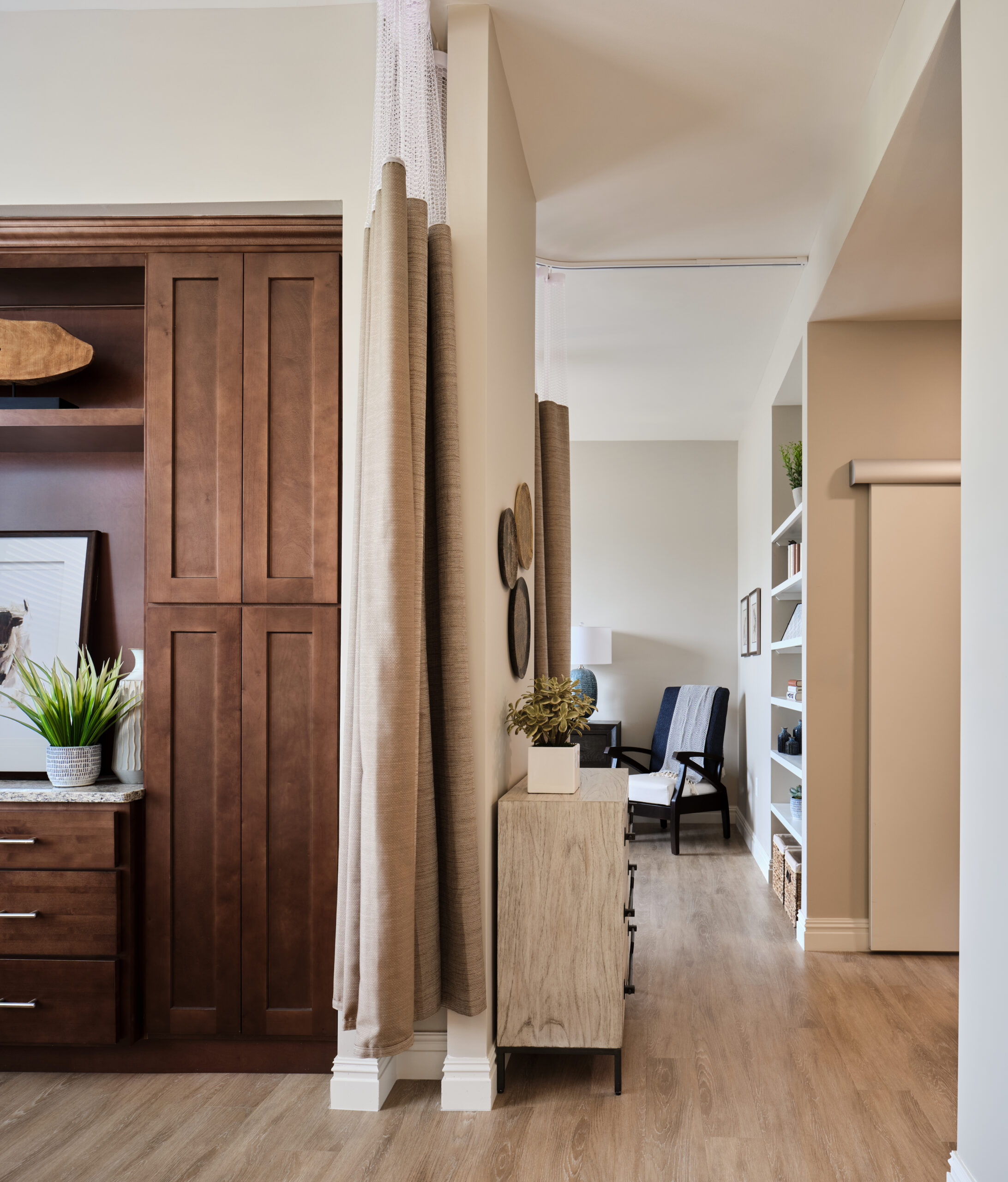
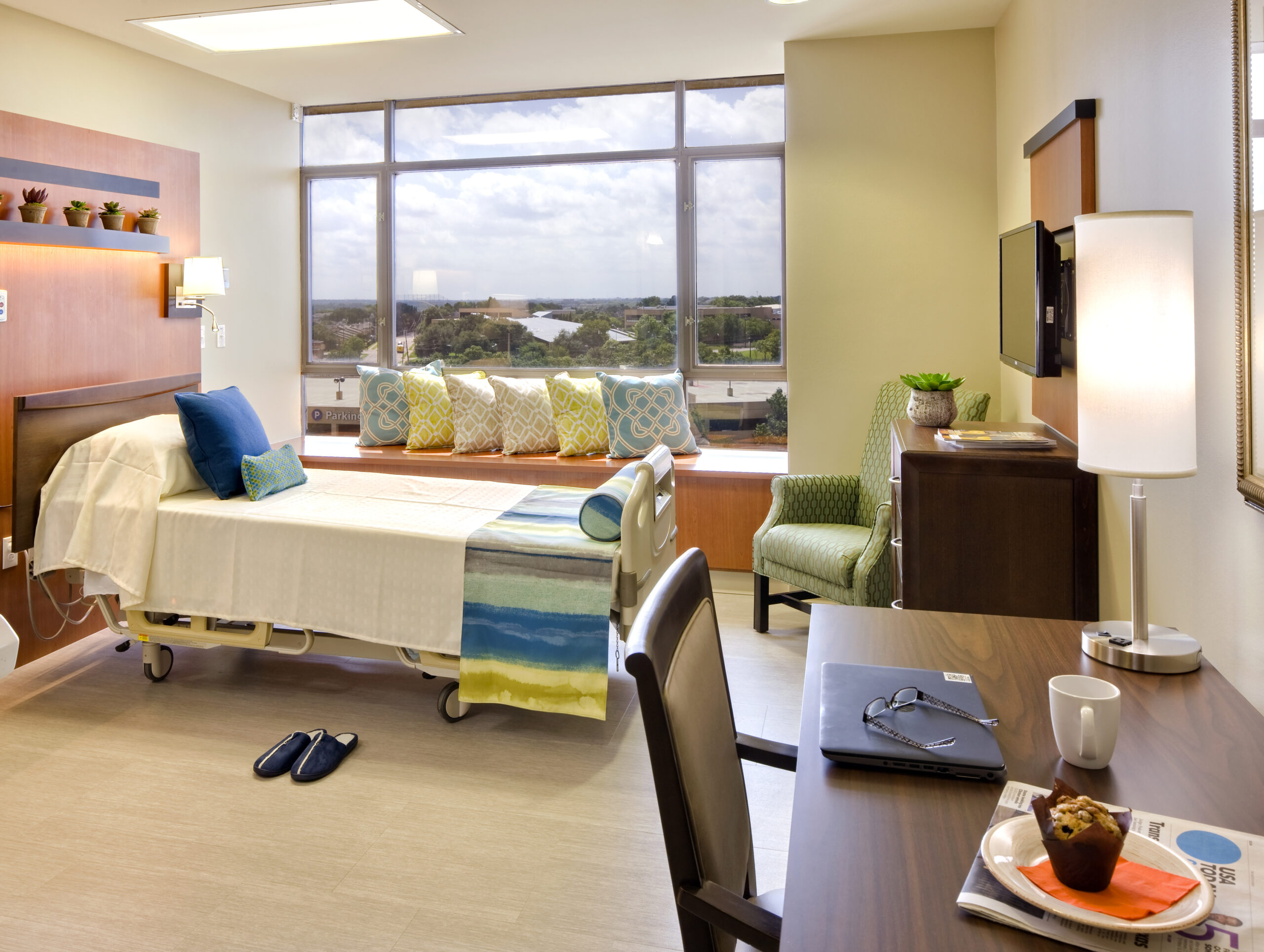
3. Create model rooms that drive ROI on unit turns
Model rooms are more than just a marketing tool — they’re an operational strategy that accelerates move-in readiness and directly impacts Net Operating Income (NOI). On average, unit turns take 22 hours and involve at least three team members. By pre-staging model rooms with durable furnishings, secure accessories, and consistent design standards, operators can cut downtime, reduce labor costs, and convert vacant units into income-generating spaces faster.
Standardized, homelike design also reduces variability in upkeep. Easy-to-clean surfaces, durable fabrics, and secured décor minimize repair calls and streamline maintenance, lowering long-term operating costs. At the same time, thoughtfully curated finishes create a welcoming environment that resonates with prospects and supports faster lease-ups.
Tip for ROI: Use model rooms as templates to streamline procurement and turnover protocols. This consistency not only reduces vacancy loss but also positions communities to stabilize occupancy and maximize returns across every unit turn.
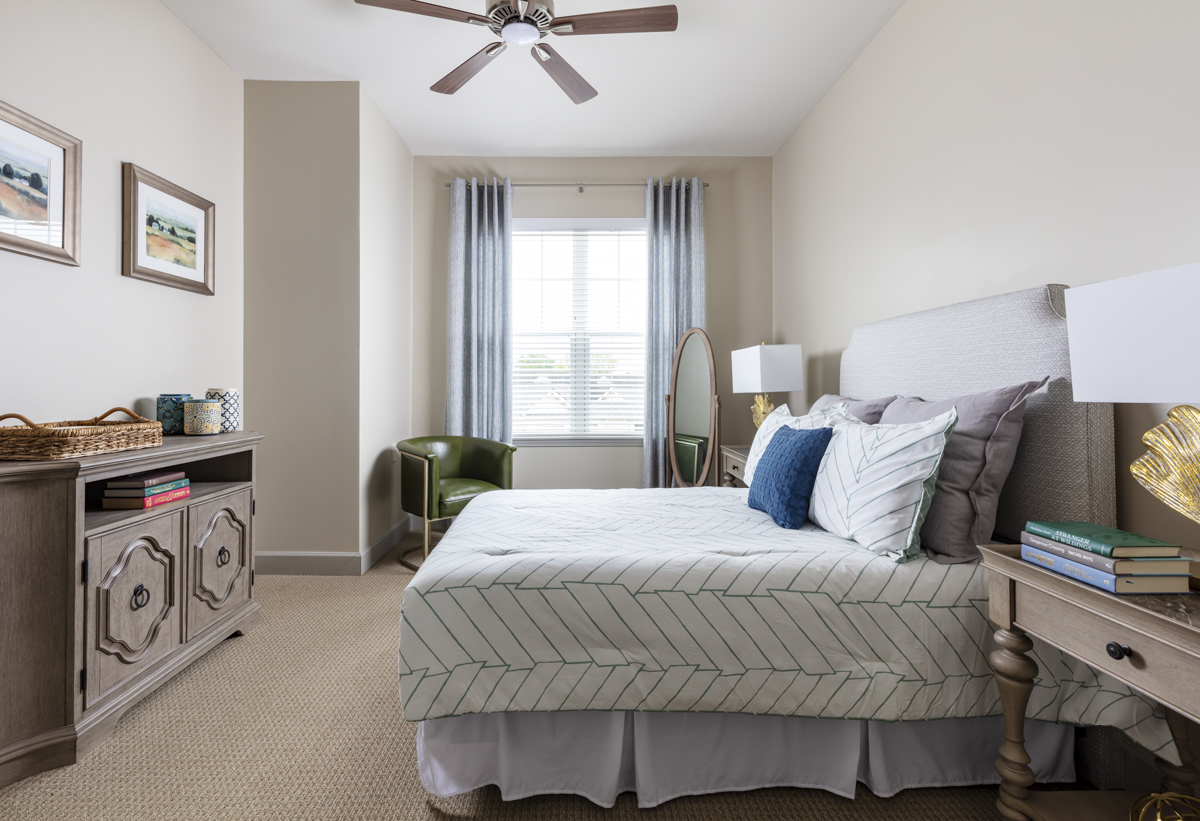
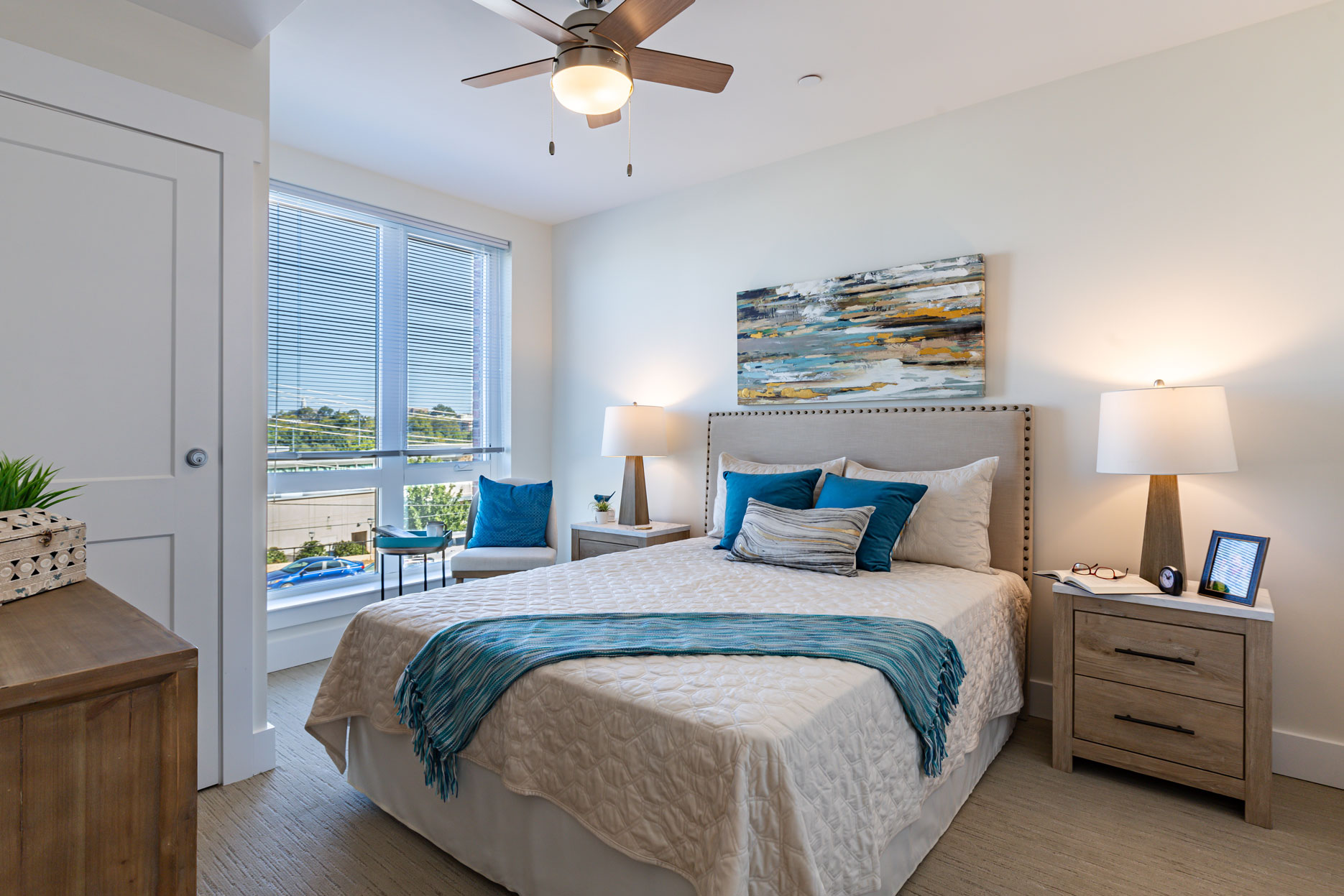
4. Integrate smart technology for safety and convenience
Smart tools, such as voice-activated lighting, thermostats, and call systems help residents manage their environment independently. These systems support routines, provide reminders, and increase comfort by reducing reliance on staff for everyday tasks. AI-enabled sensors enhance fall detection while preserving privacy and promoting peace of mind for care teams and families.
Design for both the technology itself and the people using it. Ensure strong Wi-Fi coverage and provide rooms with tech-ready outlets, USB ports, and easy-to-reach controls. Consider compatibility with accessories like smart plugs or wearable health monitors.
Beyond safety and utility, technology can enhance engagement. Smart TVs, tablets, and video call capabilities help residents stay connected with loved ones and participate in community events. These technologies also support mental stimulation through games, music, and learning apps.
Tip: Prioritize simplicity with large, intuitive icons, precise controls, and concise labeling. Offering training and ongoing support builds confidence and increases tech adoption.
5. Select durable, senior-friendly furnishings
Furniture in resident rooms must balance style, comfort, and safety with long-term durability. Chairs with tipping precautions—such as the Maxwell Thomas® SteadyTech™ anti-tip device—reduce fall risks and liability without sacrificing aesthetics. Recliners with proper seat height (18″–21″), supportive arms, and tip-resistant bases make transfers safer for residents and staff alike.
Beds should be adjustable in height with residential surrounds, allowing for both safer caregiving tasks and a more welcoming, homelike appearance. Coordinated headboards and bedding prevent the room from feeling clinical, while casters with secure locks and discreet storage for fall mats or care tools add both safety and functionality.
Looking for more senior living furnishing tips? Download our senior living furniture guide.
6. Choose long-lasting, low-maintenance materials
Materials directly impact upkeep, infection control, and resident safety. Casegoods constructed with thermolaminate or high-pressure laminate resist moisture and harsh cleaning agents, extending product life. Coated fabrics and antimicrobial finishes minimize infection risk while standing up to frequent cleaning.
Design choices should also prioritize maintenance efficiency. Minimal seams, durable coatings, and wipeable surfaces help staff maintain cleanliness quickly and effectively, while still providing soft textures and modern design that elevate the overall look and feel of the space.
Tip: When selecting casegoods, look for drawer glides and hinges that can withstand repeated use and disinfection cycles. Small details, such as edge banding and hardware durability, can make a significant difference in long-term performance.
6. The bottom line: Bringing it all together
Every detail in a resident’s room should contribute to comfort, independence, and safety. From calming palettes and personalized touches to bright lighting and future-ready furnishings, thoughtful design makes a measurable impact on care delivery and resident satisfaction.
A well-designed room doesn’t just feel like home. It improves outcomes, reduces incidents, and helps your community stand out.
Ready to enhance your resident rooms? Contact your Direct Supply account manager today to get started on personalized solutions that promote safety, comfort, and long-term value.
References:
¹ CMS, 2022
Contact us today to start your Senior Living design project, or explore resident room furniture.
Are you an interior designer? Check out senior-centric design tips >>
